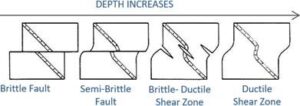Solution Exercise 1
The block diagram below shows three types of structures: a mylonitic shear zone, a thrust fault, and a set of vertical joints. The shear zone is older than the thrust fault because the former is offset by the latter (termination of type “1” in Figure 56, Section 4.2). The joints are the youngest structures because some of them abut against the thrust fault at several locations (red circles in the figure below), implying that the fault existed when the joints were formed (termination of type “2” in Figure 56). One could argue that the joints could have been displaced by the fault. However, this is not the case because the presumed movement indicated by the joint traces (red circles) is not consistent with the fault offset.

With increasing depth, brittle structures give way to ductile structures as illustrated by this modified image from Ramsay & Huber (1987).

Shear zones comprised of mylonitic rocks are ductile structures, so they were formed at greater temperature and depth, or at a deeper crustal level. The joints are typical of shallower depths where brittle deformation occurs under lower temperatures. The thrust fault was formed under intermediate depths and semi-brittle conditions because it simultaneously offsets and causes the folding of the shear zone mylonitic rocks. These structures are currently side by side because uplift took place, causing the rock mass to pass from great to intermediate and finally to shallow depth, at which point the shear zone, thrust fault and joints were formed, respectively. At the terrain surface, there is a long ridge accompanying the mylonitic shear zone. This indicates the rocks at the shear zone are more resistant to erosion than the host rock.
In this rock mass, the joints are the structures that, by themselves, are likely to be the most transmissive structures. Depending on the stress fields that affected the region after the formation of the joints, reactivation of the thrust fault surface and of the mylonitic foliation of the shear zone could have formed transmissive fractures along one or both.
